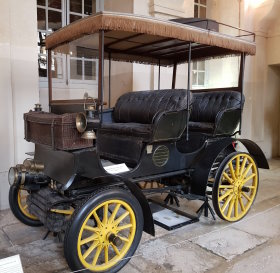Compiègne forest. Compiègne palace

Compiègne Forest, 60 km north from Paris, is a marvelous royal forest, boasting two spectacular castles. The Compiègne royal Palace has been inhabited by Napoléon. Pierrefonds is a spectacular medieval castle. Famous places in France.
Compiègne Forest
Compiègne Forest is, with Fontainebleau, one of the great royal hunting forests of France. Sixty kilometers north of Paris by A1 freeway, close to Charles de Gaulle Airport, it has superb oak and beech trees. Compiegne Forest attracts horse and bicycle riders and is a perfect destination from the city for a day. One hour train from the city to Compiègne. Check train schedules and buy tickets. Rent a bicycle at the station and you are ready for a great day.
Top Paris gardens.

Compiègne forest
Compiègne Palace
At the edge of Compiègne Forest, the Compiègne Palace is, alongside Versailles and Fontainebleau, one of the three largest royal and imperial residences in France. Built by Louis XV, it was remodeled by Napoléon I and Napoléon III. On 12 April 1807, Napoléon gave the order to completely refurbish Compiègne. The Emperor and the Empress occupied what were the grandest apartments of the First French Empire.
His nephew, Napoléon III, Emperor of France between 1852 and 1870, loved the palace and organized the famous Series there in the Autumn. One hundred guests were invited to attend for up to six weeks.
The Compiègne Palace comprises four main apartments: the apartments of the Emperor, the Empress, the King of Rome and the prince’s double apartment. They bear testament to its occupation in the 19th century.
Compiègne 60200 France

Compiègne Palace
Compiègne National Car Museum
The National Car Museum, housed in Compiègne Palace, boasts a collection of a hundred horse-drawn vehicles from the 17th to the beginning of the 20th century and thirty automobiles, testifying to the birth of the auto.
Among them, a Renault type A cart is the ancestor of our small city cars. Beside her, we see a Delahaye that belonged to the Duchess of Uzès, a committed feminist and the first woman to obtain a driving license in 1889.
Visitors stroll between a Paris bus with wooden wheels and a Citroën tankette which achieved the feat of crossing the Sahara.

The Compiègne Car Museum is one of the best
Pierrefonds Castle near Compiègne
In Compiègne Forest, the romantic and massive Pierrefonds Castle brings you back to the Middle Ages. Erected in the late 14th century by Duke Louis of Orleans, the chateau was taken down in the 17th century. It was in ruins when Napoléon III decided to commission architect Eugene Viollet-le-Duc to rebuild it. He applied his architectural designs to create the ideal chateau, such as would have existed in the Middle Ages.
Pierrefonds 60350 France

Pierrefonds in Compiègne forest
Rethondes in Compiègne Forest
Also in Compiègne Forest, you can visit the Rethondes Armistice Clearing where World War One formally ended on November 11th 1918. You can visit a replica of the carriage where Marshall Foch accepted the surrender of the German armies. The Compiègne Forest and City are especially recommended in the fall. The colors of the leaves vary from yellow to red. A great excursion from Paris.
Compiègne 60200 France

The Rethondes carriage